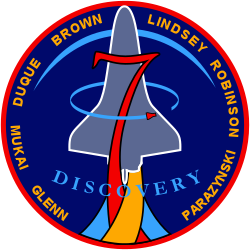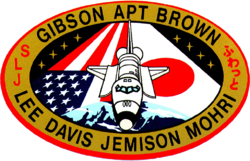Curtis Brown (Astronaut)
| Curtis Brown | |
|---|---|
 | |
| Land | USA |
| Organisation | NASA |
| ausgewählt | 5. Juni 1987 (12. NASA-Gruppe) |
| Einsätze | 6 Raumflüge |
| Start des ersten Raumflugs | 12. September 1992 |
| Landung des letzten Raumflugs | 28. Dezember 1999 |
| Zeit im Weltraum | 57d 17h 07min |
| EVA-Einsätze | 0 |
| ausgeschieden | Dezember 1999 |
| Raumflüge | |
Curtis Lee „Curt“ Brown, Jr. (* 11. März 1956 in Elizabethtown, Bladen County, North Carolina) ist ein ehemaliger US-amerikanischer Astronaut.
Leben
Brown beendete 1974 die High School in seiner Heimatstadt Elizabethtown und erwarb 1978 den Grad eines Bachelor in Elektrotechnik an der Akademie der US-Luftwaffe.
Von 1978 bis 1986 war er auf verschiedenen US-amerikanischen Luftwaffenbasen in den Vereinigten Staaten eingesetzt. Dort war er hauptsächlich als Testpilot und Fluglehrer für die A-10 und später für die F-16 tätig.
Astronautentätigkeit
Ab 1987 nahm Brown an der einjährigen Astronautenausbildung teil. Am Ende dieses Programms wurde Brown als Shuttlepilot weiter ausgebildet. Seither wurde er in vielen Funktionen innerhalb der NASA eingesetzt, vor allem als Verbindungssprecher.
STS-47
Seine erste Mission, bei der er Pilot des Shuttles Endeavour war, war der fünfzigste Raumflug eines Space Shuttles und der zweite Raumflug der Endeavour. Es war eine US-amerikanisch-japanische Weltraummission, bei der das Schwergewicht der Experimente auf Naturwissenschaften lag und auf Veränderungen der Materialien im Weltraum.
STS-66
Bei dieser Mission mit dem Shuttle Atlantis war er wieder als Pilot eingeteilt worden. Der Flug beschäftigte sich hauptsächlich mit der globalen Erwärmung und dauerte elf Tage.
STS-77
Diese Mission war seine letzte Mission, in der er als Pilot eingesetzt worden ist, wieder flog er mit der Endeavour ins Weltall. Bei dieser Mission wurden vier Objekte ins Weltall ausgesetzt, wobei der SPARTAN-Satellit nach erfolgter Mission wieder ins Raumschiff zurückgeholt wurde. Der Satellit hatte während der Mission eine Antenne ausgefahren, die so groß wie ein Tennisplatz war und nur 66 Kilogramm wog.
STS-85
Bei seiner ersten Mission als Kommandant flog Brown zum ersten Mal mit der Discovery ins All und setzte dabei den deutschen Forschungssatelliten CRISTA-SPAS (Cryogenic Infrared Spectrometers and Telescopes for the Atmosphere) zu dessen zweiter Mission aus. Dieser Satellit musste wegen der Datenübertragung immer in der Nähe des Raumschiffes sein. Ein weiterer Programmpunkt war der Test eines japanischen Roboterarmes (Manipulator Flight Demonstration MFD) für die Raumstation ISS. Mit seiner Hilfe wurden komplizierte Arbeiten ausgeführt, so das Lösen von Schrauben und das Öffnen von Türen.
STS-95
Bei dieser Mission, wieder mit der Discovery, hatte Brown die Ehre, die Mission zu führen und dabei den ältesten Menschen an Bord zu haben, der bis dahin im Weltraum war, den NASA-Veteranen des Mercury-Programms, John Glenn, der im Alter von 77 Jahren mitgenommen wurde, um die Auswirkungen der Schwerelosigkeit auf ältere Menschen zu testen. Des Weiteren war auch die erste japanische Astronautin im Weltall, Chiaki Mukai. Ferner wurde diverse Experimente unternommen und einige Ersatzteile für das Hubble Space Telescope im Orbit getestet.
STS-103
Auf seiner letzten Mission, wieder als Kommandant der Discovery, wurden das Hubble-Weltraumteleskop gewartet. Dabei erhielt das Teleskop vor allem einen neuen Rechner.
Mit diesem Flug zog er mit den Astronauten John Young, Story Musgrave, Jerry Ross und Franklin Chang-Diaz gleich, die vor ihm sechs Raumflüge absolvierten.
Zusammenfassung der Raumflüge
| Nr. | Mission | Funktion | Flugdatum | Flugdauer |
|---|---|---|---|---|
| 1 | STS-47 | Pilot | 12. September – 20. September 1992 | 7d 22h 30m |
| 2 | STS-66 | Pilot | 3. November – 14. November 1994 | 10d 22h 34m |
| 3 | STS-77 | Pilot | 19. Mai – 29. Mai 1996 | 10d 0h 39m |
| 4 | STS-85 | Kommandant | 7. August – 19. August 1997 | 11d 20h 26m |
| 5 | STS-95 | Kommandant | 29. Oktober – 7. November 1998 | 8d 21h 43m |
| 6 | STS-103 | Kommandant | 20. Dezember – 28. Dezember 1999 | 7d 23h 10m |
Nach der NASA
2013 wurde Curtis zusammen mit Eileen Collins und Bonnie Jeanne Dunbar in die Astronaut Hall of Fame aufgenommen.[1]
Siehe auch
Weblinks
- Kurzbiografie von Curtis Brown bei spacefacts.de
- NASA-Biografie von Curtis Brown (englisch; PDF)
- Biografie von Curtis Brown in der Encyclopedia Astronautica (englisch)
Einzelnachweise
- ↑ Todd Halvorson: 3 to join Astronaut Hall of Fame ranks. In: USA Today, 18. April 2013.
| Personendaten | |
|---|---|
| NAME | Brown, Curtis |
| ALTERNATIVNAMEN | Brown, Curtis Lee |
| KURZBESCHREIBUNG | US-amerikanischer Astronaut |
| GEBURTSDATUM | 11. März 1956 |
| GEBURTSORT | Elizabethtown, North Carolina |
Auf dieser Seite verwendete Medien
STS-66 Mission Insignia
The mission patch for STS-85 is designed to reflect the broad range of science and engineering payloads on the flight. The primary objectives of the mission were to measure chemical constituents in Earth's atmosphere with a free-flying satellite and to flight-test a new Japanese robotic arm designed for use on the International Space Station (ISS). STS-85 was the second flight of the satellite known as Cryogenic Infrared Spectrometers and Telescopes for the Atmosphere-Shuttle Pallet Satellite-2 CRISTA-SPAS-02. CRISTA, depicted on the right side of the patch pointing its trio of infrared telescopes at Earth's atmosphere, stands for Cryogenic Infrared Spectrometers and Telescopes for the Atmosphere. The high inclination orbit is shown as a yellow band over Earth's northern latitudes. In the Space Shuttle Discovery's open payload bay an enlarged version of the Japanese National Space Development Agency's (NASDA) Manipulator Flight Demonstration (MFD) robotic arm is shown. Also shown in the payload bay are two sets of multi-science experiments: the International Extreme Ultraviolet Hitchhiker (IEH-02) nearest the tail and the Technology Applications and Science (TAS-01) payload. Jupiter and three stars are shown to represent sources of ultraviolet energy in the universe. Comet Hale-Bopp, which was visible from Earth during the mission, is depicted at upper right. The left side of the patch symbolizes daytime operations over the Northern Hemisphere of Earth and the solar science objectives of several of the payloads.
The STS-77 crew patch displays the Shuttle Endeavour in the lower left and its reflection within the tripod and concave parabolic mirror of the SPARTAN Inflatable Antenna Experiment (IAE). The center leg of the tripod also delineates the top of the Spacehab's shape, the rest of which is outlined in gold just inside the red perimeter. The Spacehab was carried in the payload bay and housed the Commercial Float Zone Furnace (CFZF). Also depicted within the confines of the IAE mirror are the mission's rendezvous operations with the Passive Aerodynamically-Stabilized Magnetically-Damped satellite (PAM/STU) appears as a bright six-pointed star-like reflection of the sun on the edge of the mirror with Endeavour in position to track it. The sunlight on the mirror's edge, which also appears as an orbital sunset, is located over Goddard Space Flight Center, the development facility for the SPARTAN/IAE and Technology Experiments Advancing Missions in Space (TEAMS) experiments. The reflection of the Earth is oriented to show the individual countries of the crew as well as the ocean which Captain Cook explored in the original Endeavour. The mission number 77 is featured as twin stylized chevrons and an orbiting satellite as adapted from NASA's logo. The stars at the top are arranged as seen in the northern sky in the vicinity of the constellation Ursa Minor. The field of 11 stars represents both the TEAMS cluster of experiments (the four antennae of GPS Attitude and Navigation Experiment (GANE), the single canister of Liquid Metal Thermal Experiment (LMTE), the three canisters of Vented Tank Resupply Experiment (VTRE), and the three canisters of PAM/STU) and the 11th flight of Endeavour. The constellation at the right shows the fourth flight of Spacelab Experiments.
The STS-95 patch, designed by the crew, is intended to reflect the scientific, engineering, and historic elements of the mission. The Space Shuttle Discovery is shown rising over the sunlit Earth limb, representing the global benefits of the mission science and the solar science objectives of the Spartan Satellite. The bold number '7' signifies the seven members of Discovery's crew and also represents a historical link to the original seven Mercury astronauts. The STS-95 crew member John Glenn's first orbital flight is represnted by the Friendship 7 capsule. The rocket plumes symbolize the three major fields of science represented by the mission payloads: microgravity material science, medical research for humans on Earth and in space, and astronomy.
Designed by the crewmembers, the STS-103 emblem depicts the Space Shuttle Discovery approaching the Hubble Space Telescope (HST) prior to its capture and berthing. The purpose of the mission is to remove and replace some of the Telescope's older and out-of-date systems with newer, more reliable and more capable ones, and to make repairs to HST's exterior thermal insulation that has been damaged by more than nine years of exposure to the space environment. The horizontal and vertical lines centered on the Telescope symbolize the ability to reach and maintain a desired attitude in space, essential to the instrument's scientific operation. The preservation of this ability is one of the primary objectives of the mission. After the flight, the Telescope will resume its successful exploration of deep space and will continue to be used to study solar system objects, stars in the making, late phases of stellar evolution, galaxies and the early history of the universe. HST, as represented on this emblem was inspired by views from previous servicing missions, with its solar arrays illuminated by the Sun, providing a striking contrast with the blackness of space and the night side of Earth.
- The NASA insignia design for Shuttle flights is reserved for use by the astronauts and for other official use as the NASA Administrator may authorize. Public availability has been approved only in the form of illustrations by the various news media. When and if there is any change in this policy, which is not anticipated, it will be publicly announced.
The mission emblem of STS-47 depicts the Space Shuttle Orbiter with the Spacelab module in the cargo bay against a backdrop of the flags of the United States and Japan, symbolizing the side-by-side cooperation of the two nations in this mission. The land masses of Japan and Alaska are represented on the emblem emphasizing the multi-national aspect of the flight as well as the high inclination orbit of 57 degrees. The initials `SLJ' on the left border of the emblem stand for Spacelab Japan, but the name generally used for the mission is `Spacelab-J.' The Japanese characters on the right border form the word `Fuwatto' which is the Japanese word for weightlessness.
portrait astronaut curtis l. brown






